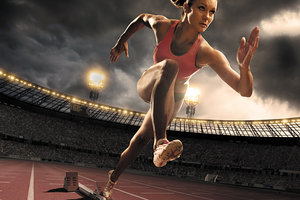So you want to specialize in sports injuries? That decision alone is a giant first step in leading the kind of life you want inside and outside the office. Narrowing your focus is critical for business and personal success.
 Long term clinical care of sporting injuries involves more than removing spinal subluxations. Restoring spinal mobility is, of course, foundational to athletic movement and performance however, soft tissue therapy and movement based corrective exercise are critical players, too. Becoming a true "game changer" in the world of sports is the epitome of the "above, down, inside out" approach to patient care. People who participate in sports from the professional to weekend warrior have a different mindset when it comes to following a therapy program; they want to get better and will do whatever it takes to do what they love better.
Long term clinical care of sporting injuries involves more than removing spinal subluxations. Restoring spinal mobility is, of course, foundational to athletic movement and performance however, soft tissue therapy and movement based corrective exercise are critical players, too. Becoming a true "game changer" in the world of sports is the epitome of the "above, down, inside out" approach to patient care. People who participate in sports from the professional to weekend warrior have a different mindset when it comes to following a therapy program; they want to get better and will do whatever it takes to do what they love better.
Patient Demographics
Specializing in sports injures takes you to a unique subculture of competition. Competition is innate. It's deeply ingrained in the human psyche. From the times of the Roman Gladiator, organized Olympic Games and the current Crossfit phenomena, people compete against themselves for a personal best or against another individual. It inspires us to push ourselves, to do more, to be more, striving for self improvement. These are powerful motivators in patient care and retention. People invest in things they value. The sense of community and support in sports is a powerful catalyst for change. When someone is hurting and you make them feel better, they will tell others. If someone wants to improve their performance and you help them do that, they will tell others. From the standpoint of practice management and marketing, specializing in sports injuries is at the top of the list.
Marketing Basics
Walk the talk! Be your sport. Participate in and do the sports you love. There is this wonderful strategy of marketing known as people skills. Connecting with and relating to people is the foundational key to long term success in business. Find out where the athletes of your sport congregate. Where do they go to do their sport? Where do they go to compete? What are their goals? What makes them tick? Become an "injury specific" marketer. What does that mean? Market to injuries specific in your chosen sport. For example, runner's get knee pain and plantar fascitiis, tennis players get elbow and shoulder pain, soccer players get knee, hip and ankle issues. Narrow your bullseye marketing target. The ripple effect is much larger when you hit the target. Focus on social media outlets to find your market. Facebook, Twitter and Meetup are essential in developing your plan of action. Even if you are not on social media, I can promise you that your target market is and if they don't see you, you lose.
Learn Movement Assessment
Movement never lies! It tells the unique story of each individual human beings history, compensations and adaptations. No two people move the same. So how can you treat people the same for an injury? You can't. Dysfunctional movement patterns may manifest in poor performance, increased injury, decreased durability and pain. Bodily injury causes movement adaptation to avoid pain. The body craves safety and stability above all else and will use any means necessary to obtain it. Assessing how an athlete moves can be a powerful predictor of injury. Previous injury and movement asymmetry (you function better on one side than the other) play a critical factor in whether an athlete will become injured again. Just because pain goes away, does not mean functional movement patterns have been restored. Physical therapist Gray Cook uses the Functional Movement Screen (FMS) scoring system to evaluate movement efficiency using seven fundamental patterns. The measured level of score can be used as a predictor of future injury. The FMS is used by professional athletic teams and health and fitness professionals as a measurable system of movement ability. Here are examples of some movements and what they might tell you:
Overhead squat: A full body evaluation of stability and mobility of the body. Can the client control movement and gravity load? Do the joints allow enough movement to hinge at the ankles, knees, hips, thoracic spine and shoulders. A quick and easy assessment of full body movement. The worse the squat, the worse the mobility and stability. It's a benchmark of where to begin in therapy.
Single Leg Stance: Demonstrates unilateral stability and functioning of the LSS (Lateral Subsystem). Increasing demands of stabilization shows underlying compensations of the body. What do the feet do? Supinate or pronate? Does the hip drop? How is balance? Does the athlete hold their breath? Does the neck and shoulder compensate. Single leg stance is critical because that is how most athletes spend their time...on one leg...running!





